AEG CPLCF489DC Manual
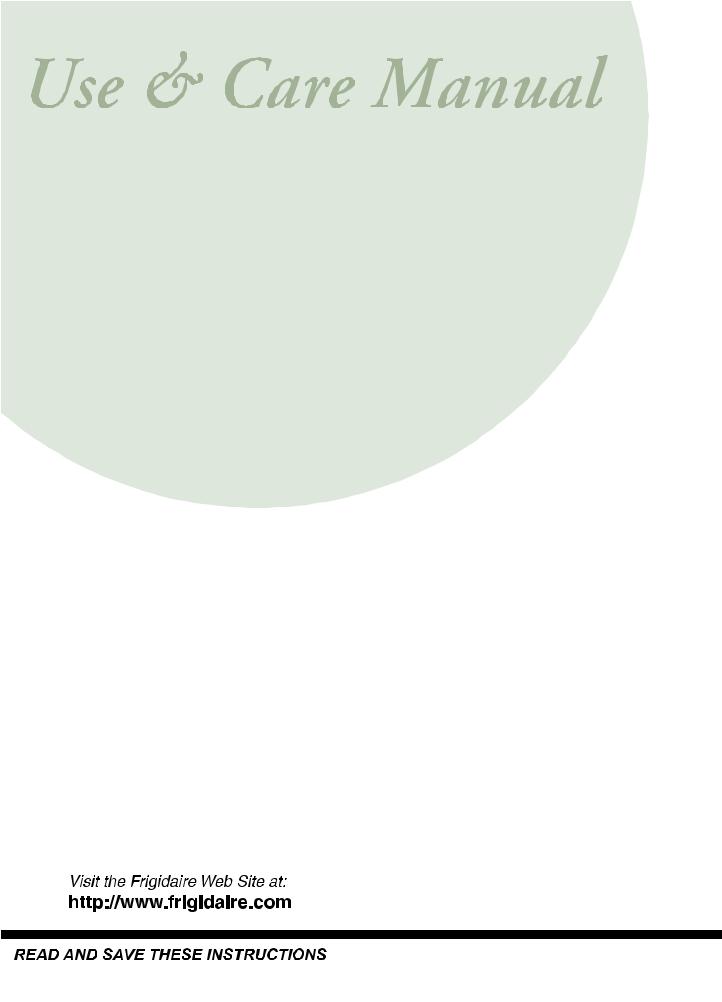
Electric
Range
CONTENTS |
Page |
Versión en español ........................................................... |
2 |
Product Registration ........................................................ |
2 |
Important Safety Instructions ...................................... |
3-5 |
Selecting Surface Cooking Utensils .................................. |
6 |
Specialty Pans & Trivets ................................................... |
6 |
Canning Tips & Information ............................................. |
7 |
Setting Surface Controls .............................................. |
7-9 |
To Operate the Warmer Zone ......................................... |
10 |
Oven Vent(s) and Racks ................................................. |
11 |
Air Circulation in the Oven .............................................. |
11 |
Oven Baking Informations .............................................. |
12 |
Broiling Informations ..................................................... |
13 |
Convection Cooking and Baking .................................... |
14 |
Convection Roasting ...................................................... |
14 |
Setting Side Oven Control .............................................. |
15 |
Self-Clean Oven Cycle ..................................................... |
16 |
Porcelain Enamel Oven |
|
Cleaning (Side Oven, If equipped) .................................. |
17 |
To Clean the Oven Bottom .............................................. |
17 |
To Clean the Cooktop Glass ..................................... |
18-19 |
Cleaning Various Parts of your Range .................... |
120-22 |
To Remove and Replace Right Oven Door ..................... |
22 |
To Remove and Replace Storage Drawer ....................... |
22 |
Changing Cooktop and / or Oven Light .......................... |
23 |
Avoid Service Checklist ............................................ |
24-25 |
Notes ........................................................................ |
26-27 |
Warranty ......................................................................... |
28 |
318200706 (0203) Rev. A
1

Product Registration
Register Your Product
The PRODUCT REGISTRATION CARD should be filled in completely, signed and returned to Electrolux Home Products North America.
Versión en español
Si desea obtener una copia en español de este Manual del Usuario, sírvase escribir a la dirección que se incluye a continuación. Solicite la P/N 318204018.
Electrolux Home Products
Attn: Care Use
P.O. Box 212378
Augusta, GA 30917
Thank you for choosing this appliance. The information contained within this
Owner's Guide will instruct you on how to properly operate and care for your range. Please read through the information contained in your literature pack to learn more about your new appliance.
Record Your Model and Serial Numbers
Record in the space provided below the model and serial numbers found on the serial plated located along the upper left corner of the oven frame behind the small oven door.
Model Number: ____________________________________________________
Serial Number: _____________________________________________________
Date of Purchase: __________________________________________________
This Owner's Guide contains general operating instructions for your range and feature information for several models. Your appliance may not have all the described features and appearance.
Note: The instructions appearing in this Owner's Guide are not meant to cover every possible condition and situation that may occur. Common sense and caution must be practiced when installing, operating and maintaining any appliance.
2

IMPORTANT SAFETY INSTRUCTIONS
Read all instructions before using this appliance. Save these instructions for future reference.
This manual contains many important safety messages. Always read and obey all safety messages.
The safety alert symbol  calls your attention to safety messages that inform you of hazards that can kill or hurt you or others, or cause damage to the product.
calls your attention to safety messages that inform you of hazards that can kill or hurt you or others, or cause damage to the product.




 Indicates an imminently hazardous situation which, if not avoided may result in death or serious injury.
Indicates an imminently hazardous situation which, if not avoided may result in death or serious injury.  Indicates an imminently hazardous situation which, if not avoided may result in minor or moderate injury, or product-
Indicates an imminently hazardous situation which, if not avoided may result in minor or moderate injury, or product-
damage-only.
All safety messages will identify the hazard, tell you how to reduce the chance of injury, and tell you what can happen if the instructions are not followed.
• All ranges can tip.
• Injury to persons could result.
•Install anti-tip device packed with range.
• See Installation Instructions.
To reduce the risk of tipping, the range must be secured by properly installed anti-tip bracket(s) provided with the range. To check if the bracket(s) is (are) installed properly, remove the lower panel or storage drawer and verify that the anti-tip bracket(s) is (are) engaged. Refer to the Installation Instructions for proper anti-tip bracket(s) installation.
•Remove all tape and packaging before using the range.
Destroy the carton and plastic bags after unpacking the range. Never allow children to play with packaging material.
•Proper Installation-Be sure your appliance is properly installed and grounded by a qualified technician in accordance with the National Electrical Code ANSI/NFPA No. 70—latest edition, and local code requirements.
Install only per installation instructions provided in the literature package for this range.
Ask your dealer to recommend a qualified technician and an authorizedrepairservice.Knowhowtodisconnectthepowerto the range at the circuit breaker or fuse box in case of an emergency.
•User servicing—Do not repair or replace any part of the applianceunlessspecificallyrecommendedinthemanuals.
All other servicing should be done only by a qualified technician, this may reduce the risk of personal injury and damage to the range.
•Never modify or alter the construction of a range by removing leveling legs, panels, wire covers, anti-tip brackets/screws, or any other part of the product.




 Stepping, leaning or sitting on the doors or drawer of this range can result in serious injuries and also cause damage to the range. Do not allow children to climb or play around the range. The weight of a child on an open door may cause the range to tip, resulting in serious burns or other injury.
Stepping, leaning or sitting on the doors or drawer of this range can result in serious injuries and also cause damage to the range. Do not allow children to climb or play around the range. The weight of a child on an open door may cause the range to tip, resulting in serious burns or other injury.




 Do not use the oven for storage.
Do not use the oven for storage.
 Do not store items of interest to children in the cabinets above a range or on backguard of a range.
Do not store items of interest to children in the cabinets above a range or on backguard of a range.
Children climbing on the range to reach items could be seriously injured.




 Never use your appliance to warming or heating the room.
Never use your appliance to warming or heating the room.
•StorageinoronAppliance—Flammablematerialsshould not be stored in an oven, near surface units. This includes paper, plastic and cloth items, such as cookbooks, plasticware and towels, as well as flammable liquids. Do not store explosives, such as aerosol cans, on or near the appliance. Flammable materials may explode and result in fire or property damage.
3
IMPORTANT SAFETY INSTRUCTIONS
•Do not leave children alone—Children should not be left alone or unattended in the area where appliance is in use. They should never be allowed to sit or stand on any part of the appliance.
•DO NOT TOUCH SURFACE UNITS, AREAS NEAR THESE UNITS, OVEN HEATING ELEMENTS OR INTERIOR SURFACES OF THE OVEN. Both surface and oven heating elements may be hot even though they are dark in color. Areas near surface units may become hot enough to cause burns. During and after use, do not touch, or let clothing or other flammable materials touch these areas until they have had sufficient time to cool. Among these areas are the cooktop, surfaces facing the cooktop, the oven vent openings and surfaces near these openings, oven door and window.
•Wear proper apparel—Loose-fitting or hanging garments should never be worn while using the appliance. Do not let clothing or other flammable materials contact hot surfaces.
•Do not use water or flour on grease fires—Smother the fire with a pan lid, or use baking soda, a dry chemical or foam-type extinguisher.
•When heating fat or grease, watch it closely. Fat or grease may catch fire if allowed to become too hot.
•Use only dry potholders—Moist or damp potholders on hot surfaces may result in burns from steam. Do not let potholders touch hot heating elements. Do not use a towel or other bulky cloth instead of a potholder.
•Do not heat unopened food containers—Build-up of pressure may cause container to burst and result in injury.
•Remove the oven doors from any unused range if it is to be stored or discarded.
IMPORTANT—Do not attempt to operate the oven during a power failure. If the power fails, always turn the ovens off. If the ovens are not turns off and the power resumes, the oven may begin to operate again. Food left unattended could catch fire or spoil.
 Electronic controllers can be damaged by cold temperatures. When you use your appliance for the first time, or if it has not been used for a long period of time, make sure that it has been exposed to a temperature above 0°C/32°F for at least 3 hours before connecting it to the power supply.
Electronic controllers can be damaged by cold temperatures. When you use your appliance for the first time, or if it has not been used for a long period of time, make sure that it has been exposed to a temperature above 0°C/32°F for at least 3 hours before connecting it to the power supply.
IMPORTANT INSTRUCTIONS FOR USING YOUR COOKTOP
•Know which knob controls each surface heating unit.
•Use proper pan size. This appliance is equipped with one or more surface units of different sizes. Select utensils having flat bottoms large enough to cover the surface unit. The use of undersized utensils will expose a portion of the surface heating to direct contact and may result in ignition of clothing. Proper relationship of utensil to the surface unit will also improve efficiency.
•Do Not Immerse or Soak Removable Heating Elements— Heating elements should never be immersed in water. Heating elements clean themselves during normal operation.
•Make sure Drip Pans or Drip Bowls Are in Place—
Absence of these pans or bowls during cooking may subject wiring or components underneath to damage.
•Utensil handles should be turned inward and not extend over adjacent surface units—To reduce the risk of burns, ignition of flammable materials, and spillage due to unintentional contact with the utensil. The handle of the utensil should be positioned so that it is turned inward, and does not extend over adjacent surface units.
•Never leave surface units unattended at high heat settings—Boilovers cause smoking and greasy spillovers that may ignite, or a pan that has boiled dry may melt.
•Protective liners—Do not use aluminum foil to line oven bottom or any other part of the appliance. Only use aluminum foil as recommended for baking if used as a cover placed on the food. Any other use of protective liners or aluminum foil may result in a risk of electric shock or fire or short circuit.
•Glazed cooking utensils—Only certain types of glass, glass/ceramic, ceramic, earthenware, or other glazed utensils are suitable for rangetop service without breaking due to the sudden change in temperature. Check the manufacturer’s recommendations for rangetop use.
•Do not use decorative surface element covers. If an element is accidentally turned on, the decorative cover will become hot and possibly melt. Burns will occur if the hot covers are touched. Damage may also be done to the cooktop.
4

IMPORTANT SAFETY INSTRUCTIONS
FOR GLASS COOKTOPS ONLY
•Do not clean or operate a broken cooktop—If cooktop should break, cleaning solutions and spillovers may penetrate the broken cooktop and create a risk of electric shock. Contact a qualified technician immediately.
•Do not touch a hot light bulb with a damp cloth. Doing so could cause the bulb to break. Disconnect the appliance or turn off the power to the appliance before removing and replacing light bulb.
•Clean cooktop glass with caution—If a wet sponge or cloth is used to wipe spills on a hot cooking area, be careful to avoid a steam burn. Some cleaners can produce harmful fumes if applied to a hot surface.
•Do not place hot cookware on cold cooktop glass. This could cause glass to break.
•Avoid scratching the cooktop glass with sharp objects.
IMPORTANT INSTRUCTIONS FOR USING YOUR OVEN
•Use care when opening oven door—Stand to the side of the range when opening the door of a hot oven. Let hot air or steam escape before you remove or replace food in the oven.
•Keep ovens vents unobstructed. Each vent has its own vent located on the top, near each side and towards the back of the cooktop. Touching the surfaces in this area when the oven is operating may cause severe burns. Also, do not place plastic or heat-sensitive items on or near an oven vent. These items could melt or ignite.
•Placement of ovens racks. Always place oven racks in desired location while ovens are cool. If rack must be moved while oven is hot use extreme caution. Use potholders and grasp the rack with both hands to reposition. Do not let potholders contact the hot heating elements in the ovens. Remove all utensils from the rack before moving.
•Do not use the broiler pan without its grid. The broiler pan and its grid allow dripping fat to drain and be kept away from the high heat of the broiler.
•Do not cover the broiler grid with aluminum foil.
Exposed fat and grease could ignite.
IMPORTANT INSTRUCTIONS FOR CLEANING YOUR RANGE
•Clean the range regularly to keep all parts free of grease that could catch fire. Exhaust fan ventilation hoods and grease filters should be kept clean. Do not allow grease to accumulate on hood or filter. Greasy deposits in the fan could catch fire. When you are flaming food under the hood, turn the fan on. Refer to the hood manufacturer’s instructions for cleaning.
•Kitchen cleaners and aerosols—Always follow the manufacturer’s recommended directions for use. Be aware that excess residue from cleaners and aerosols may ignite causing damage and injury.
SELF CLEANING OVENS
•In the self-Cleaning cycle only clean the parts listed in this Use and Care Guide. Before self cleaning the oven, remove the broiler pan and any utensils or foods from the oven.
•Do not use oven cleaners—No commercial oven cleaner or ovens liner protective coating of any kind should be used in or around any part of the oven.
•Do not clean door gasket—The door gasket is essential for a good seal. Care should be taken not to rub, damage or move the gasket.
•Remove oven racks. Oven racks color will change if left in the oven during a self-cleaning cycle.
 The health of some birds is extremely sensitive to the fumes given off during the self-cleaning cycle of any range. Move birds to another well ventilated room.
The health of some birds is extremely sensitive to the fumes given off during the self-cleaning cycle of any range. Move birds to another well ventilated room.
IMPORTANT SAFETY NOTICE
The California Safe Drinking Water and Toxic Enforcement Act requires the Governor of California to publish a list of substances known to the state to cause cancer, birth defects or other reproductive harm, and requires businesses to warn customers of potential exposure to such substances.
SAVE THESE INSTRUCTIONS
5
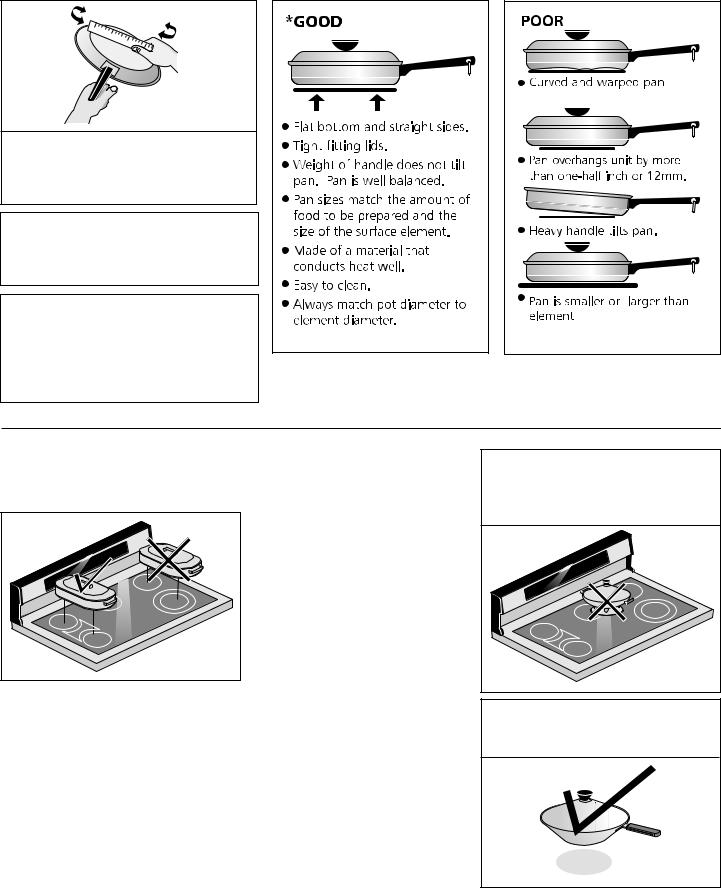
Selecting Surface
Cooking Utensils
Pans should have flat bottoms. Check for flatness by rotating a ruler across the bottom. There should be no gap between the pan and ruler.
Note: Always use a utensil for its intended purpose. Follow manufacturer's instructions. Some utensils were not made to be used in the oven or on the cooktop.
 Do not use griddle over more than one burner because it could damage your cooktop. It can also result in exposure to carbon monoxide levels above allowable current standards and be hazardous to your health.
Do not use griddle over more than one burner because it could damage your cooktop. It can also result in exposure to carbon monoxide levels above allowable current standards and be hazardous to your health.
For best result and energy conservation, choose cooking utensils that have these characteristics:
*Specialty pans such as lobster pots, griddles and pressure cookers may be used but must conform to the above recommended cookware requirements.
Specialty Pans & Trivets Woks with flat bottoms suitable for use on your cooktop are available in most
cookshop or hardware stores.
DO NOT use two elements (if the cooktop is not equipped with bridge element) to heat one large pan such as a roaster or griddle, or allow cooking utensils to boil dry. The bottom surface of the pan in either of these situations could cause discoloring or cracking of the glass range surface.
Wire trivets: Do not use wire trivets. Cookware bottoms must be in direct contact with the surface elements.
DO NOT use a wok if it is equipped with a metal ring. Because this ring traps heat, the cooktop surface could be damaged.
For glass smoothtop models, only flat bottomed woks (without support rings) may be used.
6
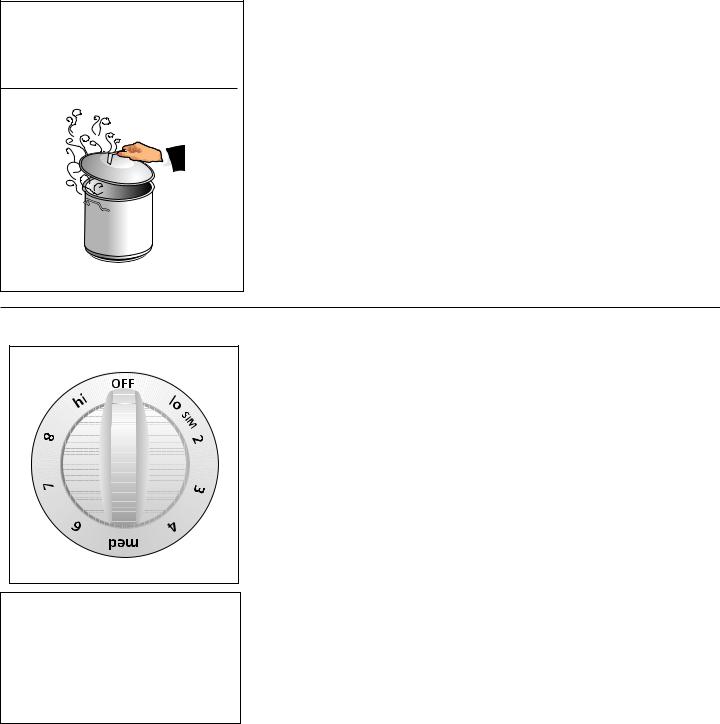
Canning Tips &
Information
 Canning can generate large amounts of steam. Use extreme caution to prevent burns. Always raise the lid to vent steam away from you.
Canning can generate large amounts of steam. Use extreme caution to prevent burns. Always raise the lid to vent steam away from you.
1.Use tested recipes and follow instructions carefully. Check with the manufacturer of glass jars for the latest canning information.
2.Use flat-bottomed canners only. Heat is spread more evenly when the bottom surface is flat.
3.Center canner on the burner grate.
4.Start with hot water and a high heat setting to reduce the time it takes to bring the water to a boil; then reduce the heat setting as low as possible to maintain a constant boil.
5.It is best to can small amounts and light loads.
 Prevent damage to cooktop:
Prevent damage to cooktop:
1.Do not use water bath or pressure canners that extend more than one inch beyond the edge of the burner grate.
2.Do not leave water bath or pressure canners on high heat for an extended amount of time.
3.Alternate surface units between each batch to allow the units and surrounding surfaces to cool down. Try to avoid canning on the same burner unit all day.
 Safe canning requires that harmful micro-organisms are destroyed and the jars are sealed completely. When canning in a water bath canner, a gentle but steady boil must be maintained continuously for the required time.
Safe canning requires that harmful micro-organisms are destroyed and the jars are sealed completely. When canning in a water bath canner, a gentle but steady boil must be maintained continuously for the required time.
Setting Surface Controls
Surface Control Knob |
Knob may look different |
 Do not place items such as salt and pepper shakers, spoon holders or plastic wrappings on top of the cooktop when it is in use. These items could melt or ignite. Potholders, towels or wood could catch fire if placed too close to the element.
Do not place items such as salt and pepper shakers, spoon holders or plastic wrappings on top of the cooktop when it is in use. These items could melt or ignite. Potholders, towels or wood could catch fire if placed too close to the element.
To Operate the Surface Element
1.Place cooking utensil on the surface element.
2.Push in and turn the Surface Control knob in either direction to the desired setting. Start most cooking operations on a higher setting and then turn to a lower setting to finish cooking. The control knobs do not have to be set exactly on a particular mark. Use the marks as a guide and adjust the control knob as needed.
3.When cooking is completed, turn the surface element off before removing the pan. Note: The surface signal light will glow when one or more elements are turned on. A quick glance at the signal light when cooking is finished is an easy check to be sure all control knobs are turned off.
Note: The size and type of utensil used, and the amount and type of food being cooked will influence the setting needed for best cooking results.
Setting |
Type of cooking |
|
|
|
|
Max (HI) |
Start most foods, bring water to a boil, pan broiling. |
|
Medium High (6) |
Continue a rapid boil, fry, deep fat fry. |
|
|
|
|
Medium (5) |
Maintain a slow boil, thicken sauces and gravies, |
|
steam vegetables. |
||
|
||
Medium Low (2-3) |
Keep food cooking, poach, stew. |
|
|
|
|
Simmer (SIM) |
Keep warm, melt, simmer. |
|
|
|
*The suggested settings found in the chart above are based on cooking in medium thickness aluminum pans with lids. Settings may vary when using other types of pans.
7
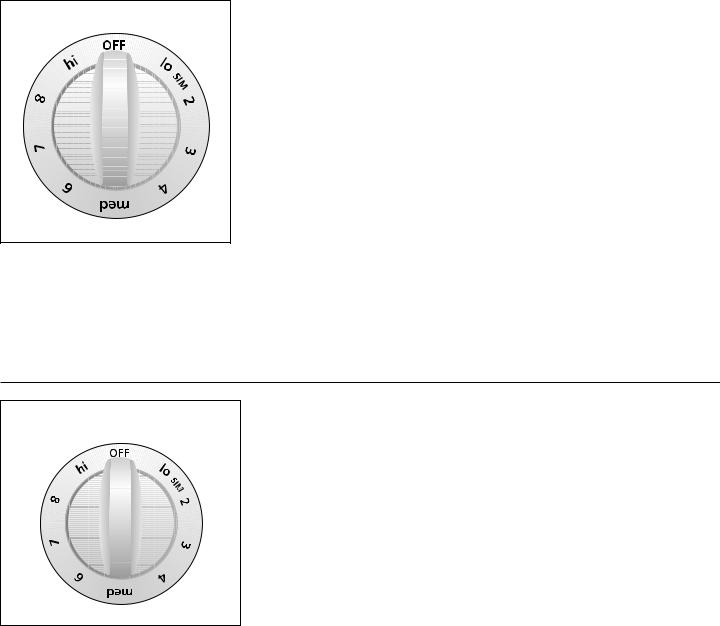
Setting Surface Controls
(continued) |
Griddle Control Knob |
Knob may look different |
To Operate the Griddle (If equipped)
Foods can be placed directly on the griddle for cooking. To remove the griddle for cleaning the burner box underneath, grasp the griddle in the front and gently pull away from plug terminal, then lift up and out. To reinstall, grasp the griddle with both hands at the end opposite the terminals and using the middle rod at the terminal end as a guide, push the griddle into place.
1.Push in and turn the griddle control in either direction to the desired setting. Start most cooking operations on a higher setting; then turn to a lower setting to finish cooking.
2.The control does not have to be set exactly on a particular mark. Use the marks as a guide and adjust the control as needed.
3.The griddle indicator light glows when the griddle is on. A quick glance at the light when cooking is finished is an easy check to be sure the control is turned off.
4.Preheat for a few minutes (until butter melts or beads of water dance on the griddle).
5.Use only nylon or plastic spatulas, spoons, etc. Metal can scratch the non-stick finish.
6.Make sure the griddle is turned OFF when cooking is finished. Leaving the griddle ON will damage it.
Approximate Griddle Settings
Bacon |
HI |
Grilled Sandwiches |
HI |
Pancakes |
HI |
Hamburgers |
MED-HI |
Eggs |
MED |
Regular Radiant |
Element Control Dial |
Knob may look different |
Note: Due to the high intensity of heat generated by the surface elements, the glass surface will turn green when the element will be turned off. This phenomenon is normal and the glass will come back to its original white color after it has completely cooled down. (White glass cooktops only).
Ceramic Glass Cooktop (some models)
The ceramic-glass cooktop has electric heating coils located below the ceramic glass surface. The design of the glass cooktop outlines the area of the surface heating unit below. Most importantly, make sure the diameter of the pan matches the diameter of the surface unit. Heat is transferred up through the surface of the cooktop. Only flat-bottomed pans should be used. The type and size of cookware, number of surface units in use and the settings of the surface units are factors that will affect the amount of the heat that will spread to areas surrounding the units. The areas surrounding the units may become hot enough to cause burns.
The cooktop should not be used as a cutting board or work surface. Dropping heavy or hard objects on the cooktop may crack it. Pans with rough bottoms may scratch the cooktop surface. Placing foods directly on the smoothtop surface (without utensils) is not recommended as difficult cleaning will result and foods may smoke and cause a potential fire hazard. Never use the griddle or similar cooking sheet on the ceramic glass cooktop.
Types of Heating Units Used
REGULAR RADIANT HEATING UNITS (some models)
The ceramic glass design shows the location of the heating surfaces.
Control knobs are used to set the heat power levels. Knobs need first to be pressed in when at OFF position, then turned to the desired heat settings.
A glowing red surface extending beyond the bottom edge of the cooking utensil indicates the utensil is too small for the unit. The control knob does not have to be set exactly on a particular mark. Use the marks as a guide and adjust the control knob as needed. The hot surface and surface indicator lights will glow.
Note: A built-in protector will automatically turn off the radiant and expandable radiant element if the ceramic-glass temperature exceeds the set limit.
8
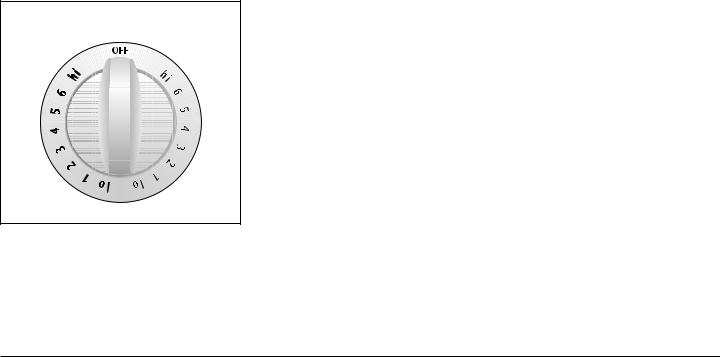
Setting Surface Controls
(continued) |
Expandable & Bridge Radiant |
Element Control Dial |
Knob may look different |
Ceramic Glass Cooktop (some models) (continued) EXPANDABLE RADIANT HEATING UNITS (some models)
This heating unit adapts to both small and large heating utensils. The unit control dial has a dual set of graduations. For small utensils use the left side of the control dial; for large utensils the right. Only the inner surface of the unit heats when using it for small utensils; the whole surface heats for large utensils. The hot surface and surface indicator lights will glow when the heating unit is turned ON.
Note: During any heat setting of the outer radiant element, the inner radiant element cycles on and off with the outer element.
BRIDGE RADIANT HEATING UNITS (some models)
Its principal advantage is to allow you to create larger cooking zone for larger pan suchs as roaster, griddle or some other specialty pans.
To use the bridge element, turn the control knob on right side, to the bridge burner graduations.
For full bridge element operation turn on the left rear burner.
To use only the front element, turn the control knob on left side, to the front burner graduations.
Indicator Lights
(for models with Ceramic Glass Cooktop)
Two different surface control lights will glow on your range: Surface Indicator Lights and Hot Surface Indicator Lights.
•The surface indicator lights, located on the control panel, glow when any surface unit is turned on. A quick glance at the lights after cooking is an easy check to be sure all surface controls are turned off.
•The hot surface indicators lights, located under the glass cooktop, will come on as the surface cooking area heats up and will continue to glow until the glass cooktop has cooled down to a moderate level. The lights may remain on even though the controls are turned to OFF.
9
